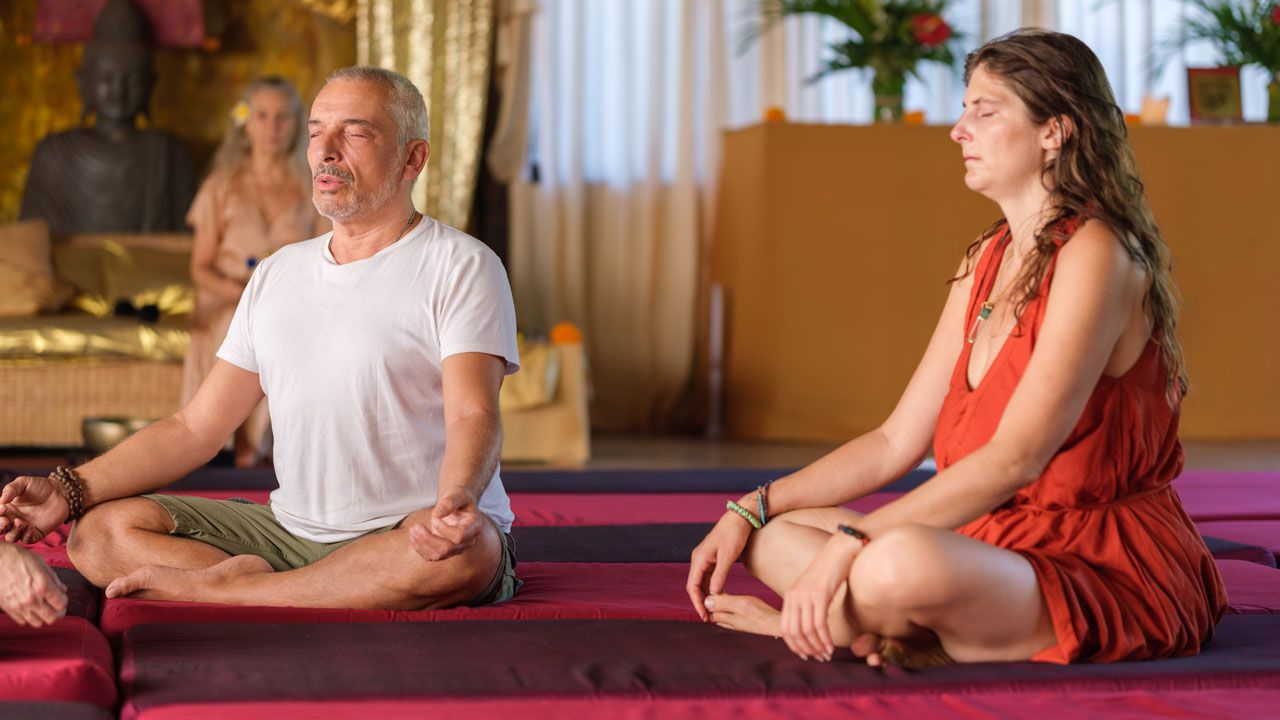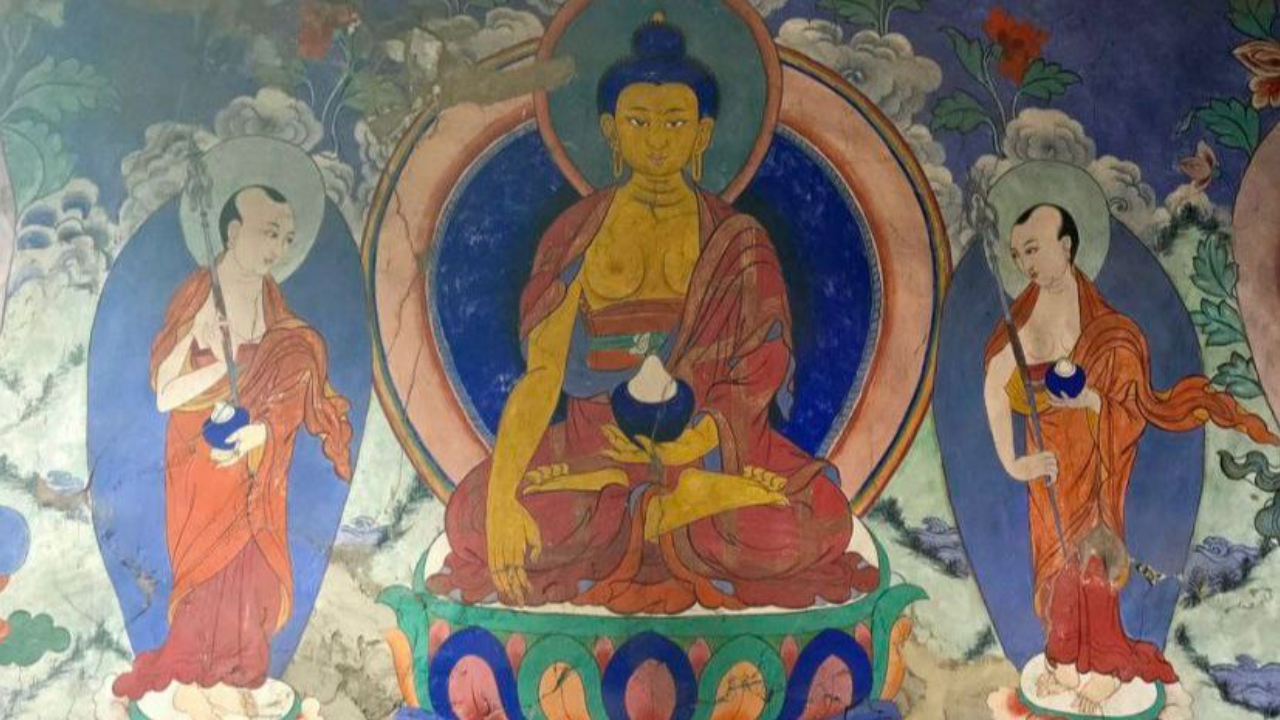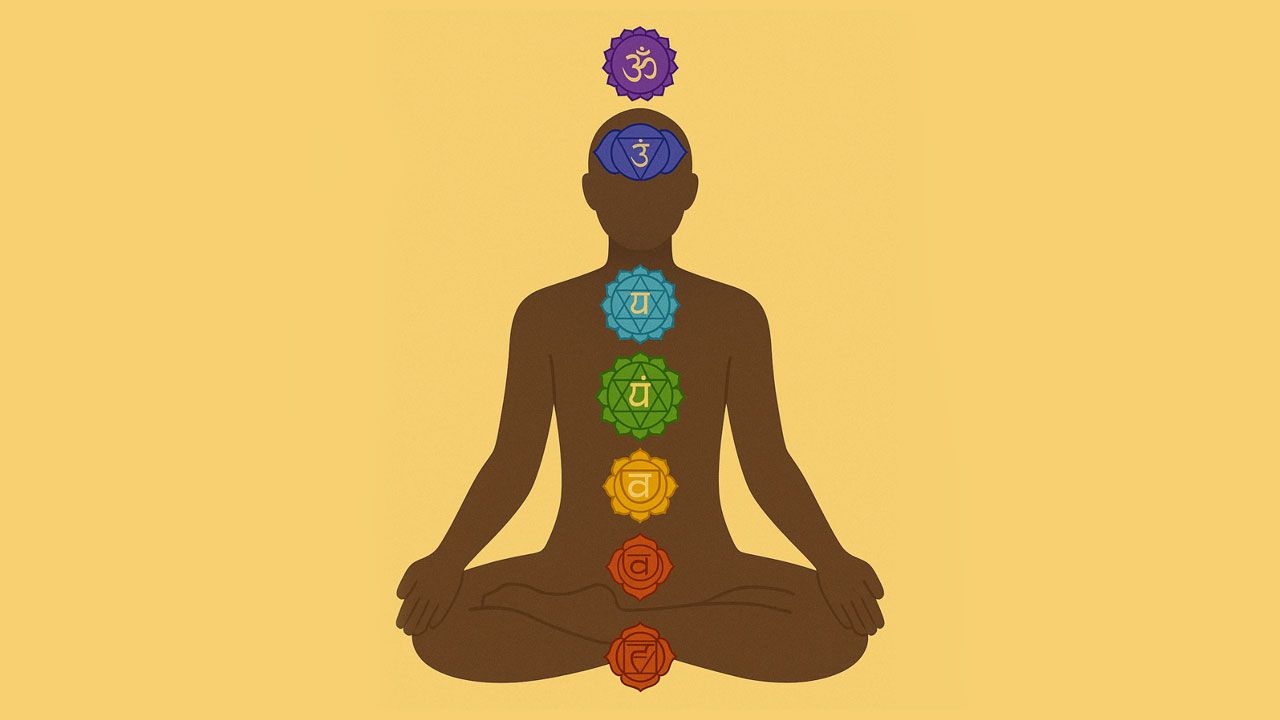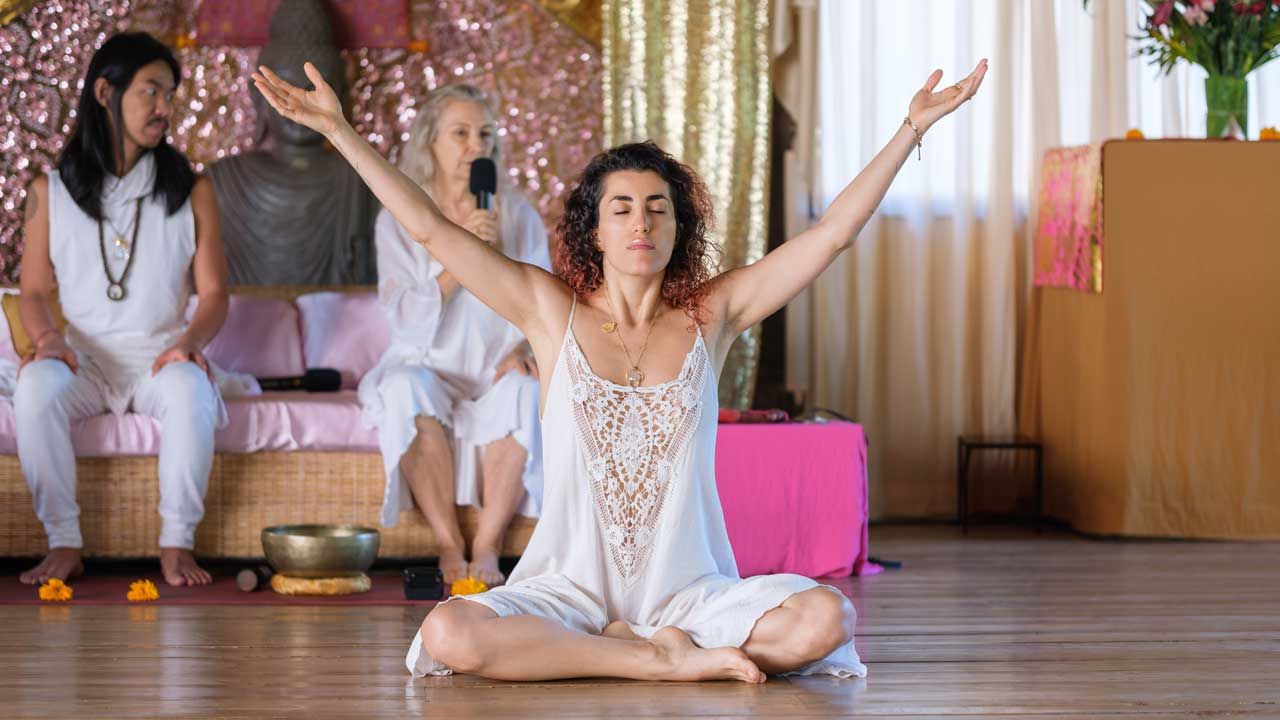The Six Bardos: A Guide to Conscious Living and Dying
Dec 25, 2024
The journey through life and death is more than just a passage from one state of existence to another, it's a continuous cycle of transitions, each offering the potential for profound transformation.
In Tibetan Buddhism, these transitional states are known as bardos, moments when the veil between worlds thins.
Understanding the Bardos in Tibetan Buddhism
The term bardo literally means “in-between” in Tibetan, and it refers to any transitional state between two phases of existence. The Tibetan word 'bardo' is used to describe these transitional states. While the bardos are traditionally associated with the period between death and rebirth, their essence extends beyond the afterlife. Every moment of life is itself a series of bardos, constantly shifting, evolving.
“Bardo is a simple method but with great significance. Only people who have meditated a little bit in their lives can be benefited by it, and Tibet was one of the countries where almost everybody was devoting some time to meditation – just to be alone, silent, not doing anything, just witnessing. If such a person does not achieve enlightenment in his life, and death intervenes, then bardo is used.” - Osho, The Path of the Mystic, Ch 7, Q 1
In Tibetan thanatology, which explores the nature of death and dying, the bardos are viewed as gateways. At the time of death, the dissolution of the physical body creates a gap in our usual perception of reality. This gap, though often filled with disorienting and terrifying visions, is also the perfect moment for enlightenment. If the individual is able to recognize the true nature of these visions as projections of their own mind, they can break free from the cycle of suffering and experience liberation.
However, the challenge lies in maintaining clarity in such a volatile state. The bardo experience is a mirror, reflecting both the positive and negative imprints we carry from our actions, thoughts, and emotions. These imprints manifest as hallucinations, heavenly or hellish, that can overwhelm the unprepared mind. But for those who have trained in meditation and mindfulness, the bardo becomes a window into the true nature of reality, beyond the illusions of fear and desire.
Tibetan teachings remind us that every moment of life is an opportunity to wake up. The transitions we face, whether through illness, loss, or personal transformation, are all bardo moments. If we learn to navigate these spaces with awareness, we can use each one as a stepping stone toward deeper spiritual insight. The potential for liberation is ever-present, if we know how to recognize it.
The bardo teachings help individuals recognize the futility of striving for an ideal self and the challenge of maintaining outer images during moments of crisis, such as facing death or giving birth. These teachings emphasize the transformative potential of surrendering to simple presence and the experience of being in the face of life's disruptions.
Read: Tantric Buddhism/Vajrayana: Beliefs, Practices, & Teachings
The Six Bardos
Tibetan Buddhism breaks down the cycle of existence into six distinct bardo states, each representing a different stage of life, death, and rebirth. These apply to the lived experiences of everyone.
- The Bardo of This Life (Kyenay Bardo): From the moment we are born until our final breath, we are living in the bardo of this life. It is here, in the day-to-day, that we have the greatest potential to prepare for the more intense bardos to come. This bardo presents us with endless opportunities to practice mindfulness, compassion, and self-awareness. Every decision, every thought, is a moment of transition, an opening to either remain trapped in the cycle of samsara (suffering) or move closer to enlightenment.
- The Bardo of Meditation (Samten Bardo): In deep meditation, we experience a subtle form of bardo. The mind quiets, and we are given the opportunity to glimpse reality beyond the usual distractions. This state is particularly significant because it serves as training for the bardo of death. Just as we learn to remain centered during meditation, we can apply that same awareness during the chaotic transitions between life and death. In this bardo, we train our mind to stay present, no matter what arises.
- The Bardo of Dream (Milam Bardo): Dreams are another form of bardo, an intermediate state between waking and sleeping. Tibetan Buddhists place great importance on dreams, seeing them as a reflection of the subconscious mind. By practicing lucid dreaming, the ability to remain aware during a dream, we can train ourselves to remain conscious during the more challenging bardos after death. Dream yoga, a spiritual practice of cultivating awareness within dreams, teaches us that even in the most surreal or nightmarish of scenarios, we can maintain clarity and control.
- The Bardo of Dying (Chikhai Bardo): The bardo begins with the outer dissolution of the body, followed by the dissolution of consciousness, presenting emotional challenges of letting go. The moment of death is one of the most profound transitions we will ever face. In this bardo, the physical body begins to dissolve, and consciousness is thrust into an unfamiliar realm. Tibetan texts describe the dissolution of the elements, earth, water, fire, air, as the body shuts down, creating sensations and visions that can either terrify or enlighten, depending on one’s level of awareness. It is said that if we can remain aware during this process, recognizing the clear light of reality, we can achieve liberation at the moment of death.
- The Bardo of Dharmata (Chonyid Bardo): Once the body has dissolved, the consciousness enters a state of heightened reality, often described as vivid and luminous. This bardo is a direct encounter with the true nature of mind, free from the distortions of the physical body. However, for those unprepared, this state can also be overwhelming, filled with intense visions and sensations. Tibetan teachings emphasize the importance of recognizing these experiences as projections of one’s own mind, rather than becoming lost in them. If recognized, this bardo offers a clear path to liberation.
- The Bardo of Existence (Sidpa Bardo): If liberation has not been achieved in the previous bardos, consciousness moves into the bardo of existence, or the process of rebirth. This is a time of intense karmic activity, where the actions from one’s previous life shape the circumstances of the next. Tibetan teachings describe this as a turbulent and disorienting time, where the consciousness is propelled toward a new body based on the unresolved karma of the past.
The Bardo of Dying (Chikhai Bardo): Encountering Peaceful and Wrathful Deities

“Now be silent. Leave this life consciously. Rather than death taking it away from you, relax your hold; don’t be defeated by death, don’t struggle. Just drop all your attachment. This world is finished for you, and this life is finished for you. There is no point in holding on to it; in holding on to it you will be fighting with death. You cannot win, and a very significant possibility will be missed. Simply let go of everything on your own accord. Relax, and accept death without any antagonism as a culmination of life, as a natural phenomenon. It ends nothing. Remain conscious and watch what is happening – how the body starts becoming more and more distant from you, how the mind starts falling into pieces as if a mirror has fallen and broken into pieces, how your emotions, sentiments, moods… everything that made your life starts disappearing.” - Osho, The Path of the Mystic, Ch 7, Q 1
The Bardo of Dying, often referred to as the painful bardo, or Chikhai bardo, challenges our deepest attachments, not just to life itself, but to our very sense of identity. As the physical body begins its inevitable dissolution, the ego, the “self” we’ve spent our entire life constructing, begins to unravel. This bardo is painful because it demands that we release everything: our relationships, our achievements, our sense of control, and even our body, which we’ve known as the vessel of our existence. The fear and anguish that arise from this dissolution stem from a natural resistance to letting go, to losing everything we believe defines us.
When I had a NDE, (near death experience) in my teenage years, I had no awareness of this dimension of exitance. I felt the sensation of every part of my life and essence being layed out in front of me. This reminds me of the saying that “your life flashes in front of your eyes” at the moment of death. I tried everything i could to “hold onto” or “catch” myself, as I felt a anguishing feeling that me, my identity, all that I know and identify with, is being taken away from me. In Christianity, they refer to “hell”. But I believe that this disillusion of the ego, this “losing” of the identity we have attached with, is the true experience of hell.
Tibetan teachings guide us to recognize that this suffering can be transformed. By loosening our grip, by releasing the attachments that bind us to the physical world, the Bardo of Dying shifts from a space of torment into a passage of profound opportunity. Letting go does not mean falling into the void, it means stepping beyond the illusion of permanence and stepping into the deeper reality of existence.
The Intermediate State: A Journey Through the Mind
When the body ceases to function, what remains is pure consciousness, a journey through the mind, unfiltered by the distractions of the physical world. The Intermediate State (Bardo) is like a mirror, reflecting the depths of our inner landscape. In this state, the mind is unshackled from the confines of the body and time.
The mental body operates in the bardo state, traveling instantaneously and reflecting our thoughts. For those unprepared, this can be a disorienting experience, as everything we’ve suppressed, ignored, or avoided during life surfaces in full force. The memories, emotions, and unresolved karma from our lifetime are no longer hidden by the distractions of the material world.
At its essence, the mind is the same for all beings, but what distinguishes our experience in this bardo is the surface structure, the layers of conditioning, fear, attachment, and desire that we’ve accumulated throughout life. These mental projections take on vivid, sometimes overwhelming forms. For some, the journey is filled with terrifying visions; for others, it is a time of extraordinary beauty and clarity. This bardo is a direct reflection of our mental patterns and karmic imprints.
The real power of the intermediate state is that it offers us a rare opportunity to confront and transform these patterns. In life, meditation acts as the training ground for this moment. Through meditative practice, we learn to observe the mind’s movements without getting caught in them, to recognize projections for what they are, illusions, rather than reality.
In the Bardo of the Intermediate State, this skill becomes invaluable. If we can recognize that these visions, whether blissful or terrifying, are products of the mind, we can transcend them. The power of our karmic imprints becomes clear, as positive actions from our lifetime create experiences of peace, while negative actions bring forth confusion and suffering.
Preparing for the Bardos in Tibetan Tradition

Tibetan Buddhism emphasizes that death is not something to be feared or ignored; it is an essential part of the spiritual journey, and the time to prepare for it is while we are still alive. Meditation is more than a practice of calming the mind; it is a profound preparation for death itself. By meditating on the nature of the mind, we familiarize ourselves with the terrain of the bardos, so that when death comes, we are not caught off guard.
The present moment embodies a continual bardo, representing a state suspended between the past and the future, thus illustrating how the essence of this experience is always present in our lives.
Our karma, our actions, thoughts, and intentions, play a powerful role in shaping the experiences we will face in the bardos. Positive karma acts as a guide, offering protection and clarity as we navigate these liminal spaces. Conversely, unresolved negative karma can cloud our perception, pulling us into cycles of fear and confusion. Meditation allows us to engage with our karma constructively, recognizing and transforming the patterns that might otherwise trap us in suffering.
Even a brief experience of the mind’s true nature, the luminous, clear awareness beyond the layers of ego, can change how we face death. This glimpse of clarity acts as an anchor, a point of reference that helps us stay grounded as we transition through the bardos. Even if the visions and sensations we encounter are overwhelming, this inner knowing allows us to remain steady, navigating these realms with calm and insight.
For those who practice tantric Buddhism, death presents an even greater opportunity. Through tantric practices, practitioners learn to enter into states of heightened awareness and clarity, cultivating the potential to enter the pure lands, realms of ineffable joy and peace, manifested by the compassion of enlightened beings. These realms offer a refuge from the cycle of birth and death, a place where the mind can rest in its purest, most luminous state.
“Bardo is reminding you that what is disappearing was a dream. It is very easy when death is coming to see your life as a dream. What else can it be? It is just as if you are waking up in the morning. The whole night you have lived so much, so many dreams – you may have lived years in the night – but bardo reminds you that it was a dream. It has to be done by a very evolved being – a lama, a master – and he insists that it is time to realize that it was a dream: you are not dying, only the dream is broken. And while you are being shifted from one dream to another… the gap is of tremendous importance because in that gap there is no dream, there is simple clarity, absolute clarity, awareness. So the second point to be reminded of is: don’t miss the gap.” - Osho, The Path of the Mystic, Ch 7, Q 1
Letting Go in the Bardos

The Role of Energy in Sacred Sexuality
The key to navigating the bardos is letting go, not just of our attachments to life, but of the very constructs that define our existence. Tibetan Buddhism teaches the concept of shunyata, or “emptiness,” which refers to the ultimate nature of reality. This emptiness is not a void or absence, but rather the realization that all things, including our identity, our world, and our experiences, are transient and without fixed essence.
Individuals often create a false sense of comfort by clinging to an inherent continuity in life, which ultimately disrupts their understanding of reality.
“Letting go is not an act of resignation, it is a joyful release, an acknowledgment that we no longer need to follow the rigid patterns and expectations that once defined us. Tibetan texts describe this state as one of ‘majestic utter sameness,’ where the distinctions between mind and appearance dissolve, and we rest in the pure fact of being. In this state, the mind is open, free, and playful, no longer bound by the artificial constraints of the ego.” - Osho, The Path of the Mystic, Ch 7, Q 1
The grasping that causes suffering is based on the mistaken belief that things are solid, permanent, and under our control. This grasping can be especially painful in the bardos, where the illusions we’ve held onto during life are exposed and stripped away. But within this experience of shunyata lies immense freedom. When we stop trying to hold onto what is falling away, we discover the spaciousness and openness that lies beneath the surface.
The Role of Karma in the Bardos
In the Bardo of Becoming, the winds of karma determine our experiences. This transitional state is governed by the karmic energy accumulated throughout our lives, and here, thought becomes reality in a way that is more immediate and intense than during our physical existence. The mind is restless in this bardo, and its journey is shaped by the thoughts, words, and deeds we have engaged in while alive. Tibetan Buddhism teaches that the most crucial preparation for this stage is developing stability of mind through meditation, as it allows us to navigate these turbulent karmic winds with greater clarity and calmness.
The essence of mind is unified among all sentient beings, while individual experiences and surface structures differ. Recognizing this shared essence is crucial during meditative practices and the process of dying.
The Tibetan understanding of death rests on the belief that everything we experience in life, death, and the bardo is the direct result of our own actions. Nothing is imposed upon us by an external force or deity—our experiences in the bardos are self-created. This echoes the teachings of Tulku Thondup in his bookPeaceful Death, Joyful Rebirth, where he explains that death is not followed by an external judgment but rather a natural unfolding of the karma we have generated. The bardos, therefore, are less about divine judgment and more about the dividends we collect from our mental and emotional investments throughout life.
Our karmic imprints, whether positive or negative, manifest themselves vividly in the bardos. If we have cultivated virtue, mindfulness, and compassion in life, these positive actions serve as guiding forces, creating peaceful and luminous experiences during the transition. Conversely, unresolved negative karma can lead to confusion, fear, and suffering as it takes form in this heightened state of consciousness. The bardo, then, is not just a time of uncertainty but also a powerful mirror reflecting the totality of our past actions.
Bardo Meditation

This meditation practice that Ma Ananda Sarita received in a moment of spiritual connection during the passing of a loved one is designed to help both the deceased and the living navigate the transition through the bardos. This meditation is not just a tool for assisting the departed. It also serves those left behind, helping them process grief and move toward peace.
When someone leaves this world with unresolved issues or unfinished business, their energy can weigh heavily on the loved ones they leave behind. This meditation works to clear these lingering energies, offering a path to transcendence for both parties. In essence, it is a spiritual act of helping the deceased clear their "closets," allowing them to move forward into the light.
Instructions for Bardo Meditation
This meditation series is best started very soon after your loved one has left their body. For 10 consecutive days, for 20 minutes each time you practice this method, those close to the deceased should sit before a photograph of the person, with a lit candle nearby. The purpose of this practice is to join the loved one where they are in the bardo, through the power of intention and energy.
By focusing your awareness on the photograph and the candle, and consciously requesting your consciousness to join your dearly departed in the bardo they are in at this time, you begin to attune yourself to the bardo realm your loved one is traversing. Each day, you will connect to a different bardo level, as the deceased moves through various layers of consciousness.
During the meditation, focus your full attention on the bardo realm. Be a non-judgmental presence, as the deceased may be experiencing the surfacing of memories, unresolved emotions, or unfulfilled desires. These experiences manifest in the form of dreamlike realities, sometimes heavenly, sometimes hellish, depending on the weight of unfinished business. Your role is to shine the light of awareness, helping the deceased unwind these patterns and find release.
After 20 minutes, blow out the candle, using hand gestures to break the energetic connection. Affirm out loud that you are leaving the bardo and returning to the earthly plane, then wash your hands up to the elbow with fresh water. Repeat this process for 10-12 days. By the end of this period, you may feel that your loved one has moved toward the light.
In a final session, offer a prayer for the deceased’s rebirth into a higher state of consciousness. For those with heightened psychic sensitivity, you may even witness the moment of rebirth and glimpse their new destiny.
Additional Rituals for Assisting the Deceased
Covering mirrors used by the deceased with black cloth can help prevent confusion, as the deceased may seek their reflection in the mirror, trying to reconnect with their old form. Encouraging them to move toward the light instead of lingering on the earthly plane is crucial for their peaceful transition. This is why Tibetan teachings often favor cremation over burial.
Cremation encourages the deceased to release their attachment to the body, whereas burial can lead to confusion and the phenomenon of restless spirits. In the Tibetan tradition, cremation is preferred to help the deceased let go of their physical form and move on to the next stage of their spiritual journey.
According to Osho, attending a funeral or cremation also requires ritual purification. After the ceremony, it’s important to wash the clothes worn at the event and cleanse yourself by taking a shower and washing your hair, symbolically releasing the energy of death.
Conclusion
The bardo serves as a powerful symbol of transformation and liberation, constantly reminding us of the impermanence of life and the importance of living with awareness. The peaceful and wrathful deities mentioned in the Tibetan Book of the Dead represent the transformation of the self, guiding us through the inner journey of the mind during these liminal states.
Ultimately, the final breath marks the closing of one cycle and the beginning of another. The bardos show us that life and death are not opposites but part of a continuous flow. By preparing through meditation, understanding karma, and engaging with the profound teachings of the bardos, we open ourselves to the possibility of living and dying with peace, clarity, and a deeper understanding of our true nature.















